中考英语语法大全——状语从句(共31张PPT)
文档属性
| 名称 | 中考英语语法大全——状语从句(共31张PPT) |

|
|
| 格式 | ppt | ||
| 文件大小 | 1.8MB | ||
| 资源类型 | 教案 | ||
| 版本资源 | 通用版 | ||
| 科目 | 英语 | ||
| 更新时间 | 2022-04-10 18:50:11 | ||
图片预览



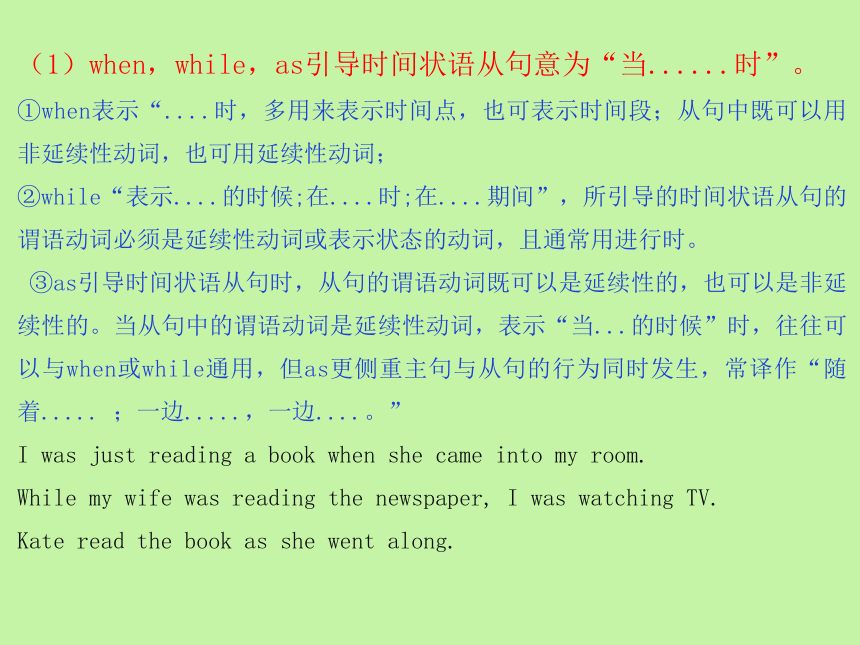
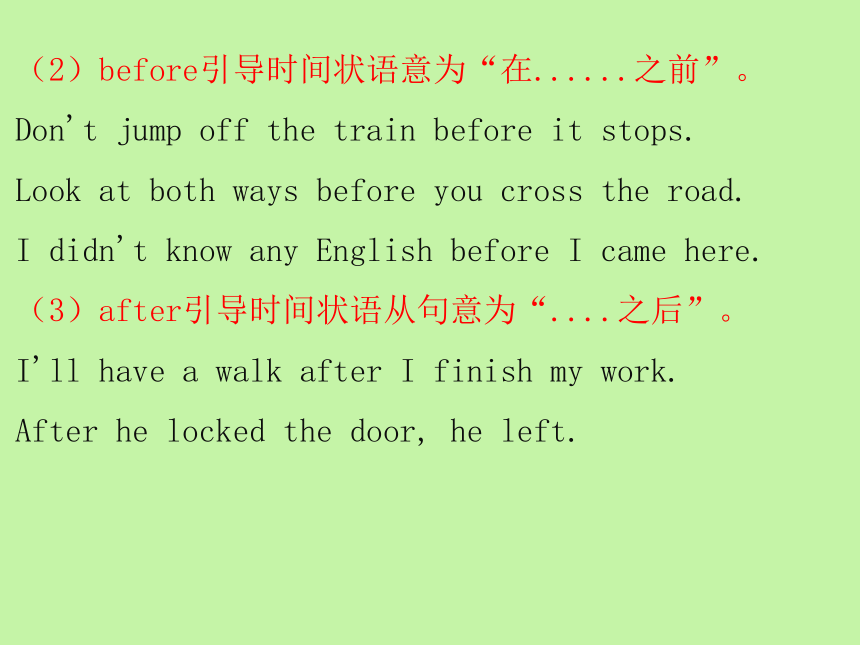
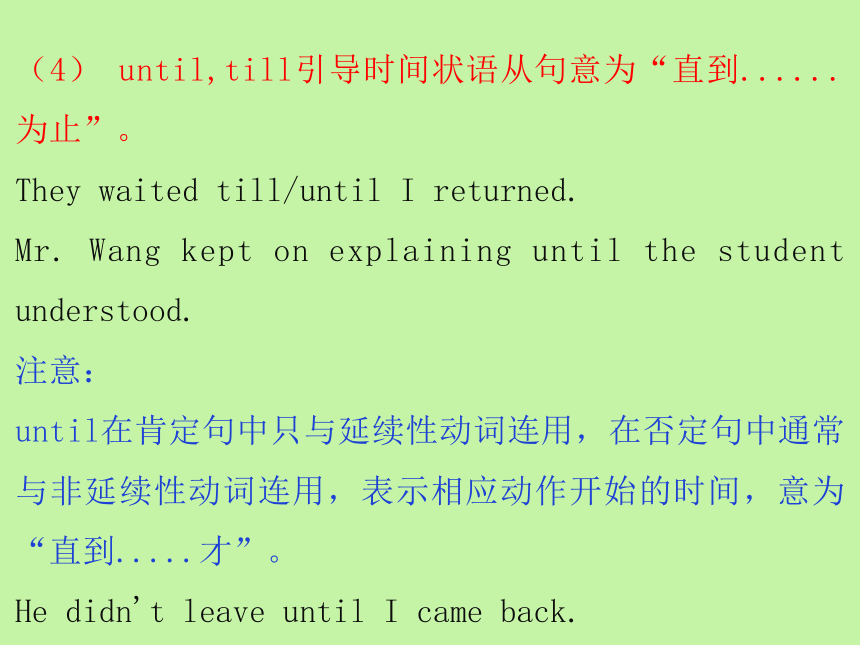
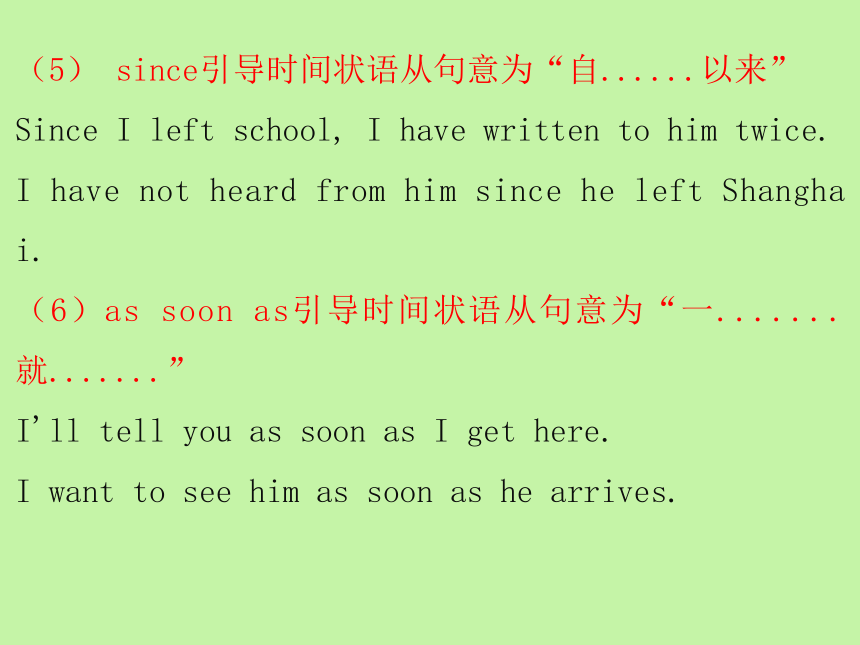

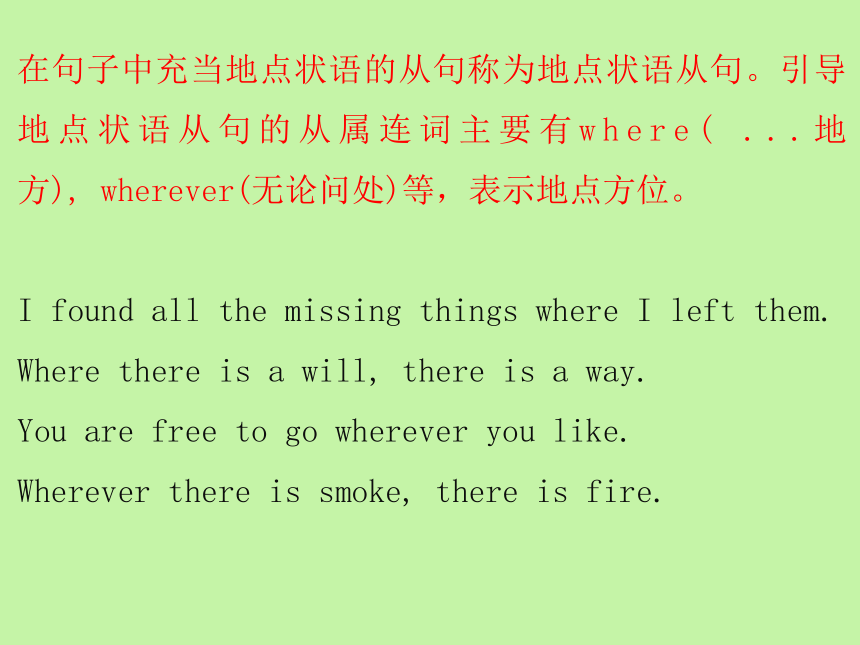

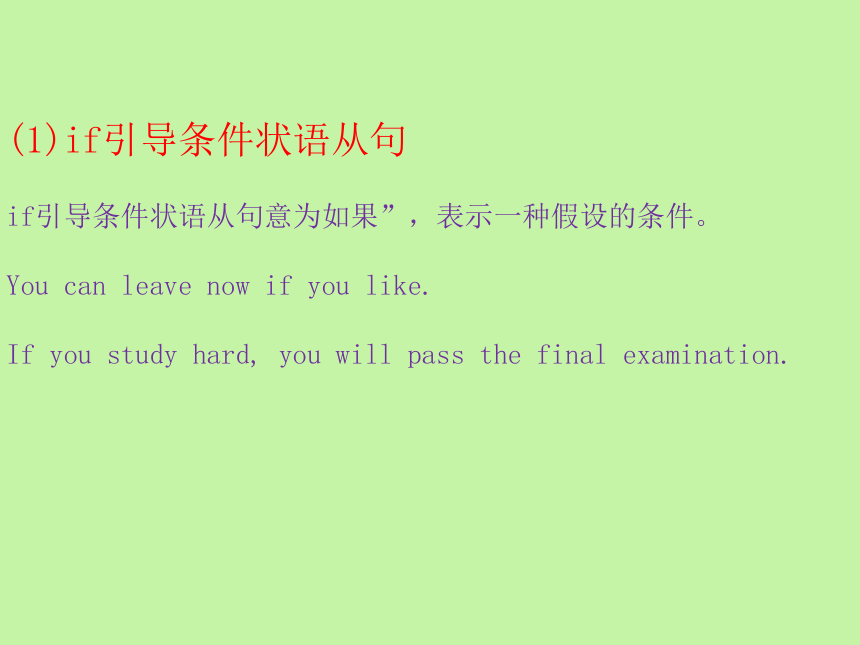
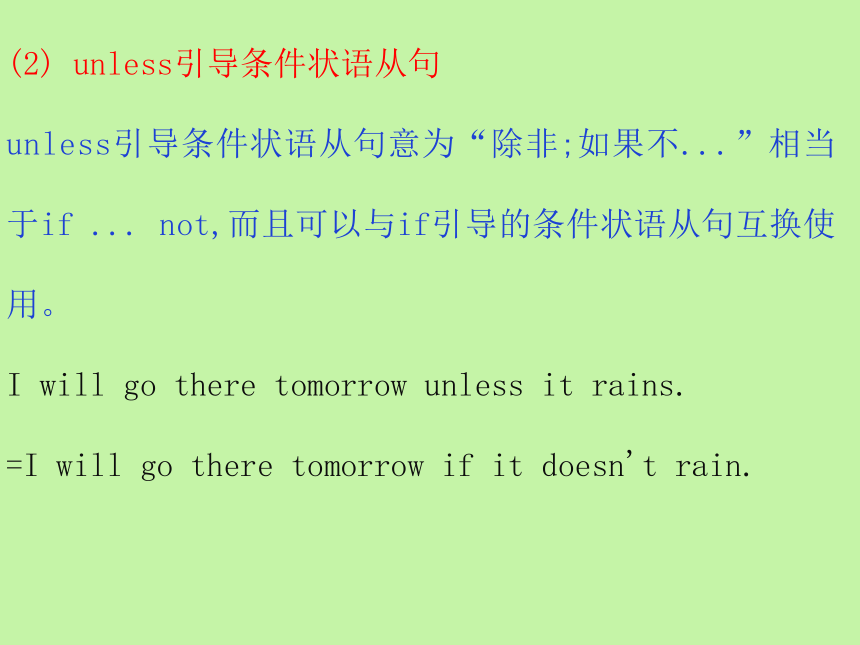
文档简介
(共31张PPT)
在句中起状语作用的从句叫作状语从句。状语从句可以位于句前、向中成向居。位于句首时,常用迅号与主句隔开,位于句中时以句前后须用过号,位于句居时,从句的前面可以不用逗号。
状语从句主要包括时间状语从句地点状语从句、条件状语从句、原因状语从句、目的状语从句、结果状语从句、让步状语从句方式状语从句和比较状语从句。
时间状语从句
(1)when,while,as引导时间状语从句意为“当......时”。
①when表示“....时,多用来表示时间点,也可表示时间段;从句中既可以用非延续性动词,也可用延续性动词;
②while“表示....的时候;在....时;在....期间”,所引导的时间状语从句的谓语动词必须是延续性动词或表示状态的动词,且通常用进行时。
③as引导时间状语从句时,从句的谓语动词既可以是延续性的,也可以是非延续性的。当从句中的谓语动词是延续性动词,表示“当...的时候”时,往往可以与when或while通用,但as更侧重主句与从句的行为同时发生,常译作“随着..... ;一边.....,一边....。”
I was just reading a book when she came into my room.
While my wife was reading the newspaper, I was watching TV.
Kate read the book as she went along.
(2)before引导时间状语意为“在......之前”。
Don't jump off the train before it stops.
Look at both ways before you cross the road.
I didn't know any English before I came here.
(3)after引导时间状语从句意为“....之后”。
I'll have a walk after I finish my work.
After he locked the door, he left.
(4) until,till引导时间状语从句意为“直到......为止”。
They waited till/until I returned.
Mr. Wang kept on explaining until the student understood.
注意:
until在肯定句中只与延续性动词连用,在否定句中通常与非延续性动词连用,表示相应动作开始的时间,意为“直到.....才”。
He didn't leave until I came back.
(5) since引导时间状语从句意为“自......以来”
Since I left school, I have written to him twice.
I have not heard from him since he left Shanghai.
(6)as soon as引导时间状语从句意为“一.......就.......”
I'll tell you as soon as I get here.
I want to see him as soon as he arrives.
地点状语从句
在句子中充当地点状语的从句称为地点状语从句。引导地点状语从句的从属连词主要有where( ...地方), wherever(无论问处)等,表示地点方位。
I found all the missing things where I left them.
Where there is a will, there is a way.
You are free to go wherever you like.
Wherever there is smoke, there is fire.
条件状语从句
(1)if引导条件状语从句
if引导条件状语从句意为如果”,表示一种假设的条件。
You can leave now if you like.
If you study hard, you will pass the final examination.
(2) unless引导条件状语从句
unless引导条件状语从句意为“除非;如果不...”相当于if ... not,而且可以与if引导的条件状语从句互换使用。
I will go there tomorrow unless it rains.
=I will go there tomorrow if it doesn't rain.
(3) so/as long as引导条件状语从句
so long as或as long as引导条件状语从句意为“只要”
So/As long as you promise to go, I'll surely go.
原因状语从句
1. because的用法
because 表示的因果关系最强,常用来回答why提出的问题,意为“因为”。所引出的原因往往是说话者所不知道的或者最感兴趣的。because引导的原因状语从句往往比主句显得更重要。
I came back late yesterday because I was on duty. 。Because Tom was ill, he didn't come to school. Why didn't you give Dick a call
--- Because I will see him soon.
2. since的用法
since表示人们已经知道的事实,不需要强调的原因,常意为“既然....”通常放在句首。since引导的从句是次要的,重点强调主从 句的内容。
Since everyone is here, let's get started.
Since you are free tonight. why not drop in and play chess with me
3. as的用法
as表示的原因只是对结果的附加说明,位于句首、句尾均可。as从句不可用于强调结构。
She didn't hear us come in as she was asleep.
As you weren't there, I left a message.
目的状语从句
(1)so that引目的状语从何意为“以便;为了”,通常放在主句之后,从句中一般含有can,could,may,might,will,would等情态动词。
I left at 6:00 so that I could catch the train.
She dresses like that so that everyone will catch her.
(2)in order that引导目的状语从句意为“为了”,所引导的目的状语从句既可以放在主句前,也可以放在可以放在主句后。
The teacher spoke very slowly in order that we could follow her.
结果状语从句
1. so... that...的用法
在so...that....结构中, so是副词,修饰形容词或副词。引导结果状语从句时,常用于以下结构:
so+形容词/副词
so+many few(+复数可数名词) that+从句
so+much/ little(+不可数名词)
so+ 形容词+a(n)+单数可数名词+ that 从句
Kathy is so lovely that we all like to play with her.
He made so many mistakes that he failed the exam once again.
2. such...that...的用法
在such... that... 结构中,such是形容词,修饰名词或名词短语。引导结果状语从句时,常用于以下结构:
a(n)+形容词+单数可数名词
so+ such+ 形容词+复数可数名词 +that+从句
形容词+不可数名词
His plan was such a good one that we all agreed to accept it.
They are such kind-hearted teachers that people in the village all respect them.
让步状语从句
1. though, although的用法
though和although的意义相同,多数情况下可以互换使用。主句可用yet或still,更加强调对比性。
We were not tired though we had worked all day.
The article is very important although it is short.
2. even if, even though的用法
even if, even though表示语气更强的让步,意为“即使”。even if更强调对“假设”的让步, even though更加强调对“既成事实”的让步。
We'll make a tip even though the weather is bad.
Even though he is 20, he is sill like a little child.
方式状语从句
1. as的用法
as引导方式状语从句,意为“..的方式,如同”。
Will you do the experiment as I am doing
Leave the children as they are.
2. as if/as though的用法
两者引导的方式状语从句所表示的情况是事实或者具有很大的可能性时,通常用陈述语气。
It looks as if/though it were going to rain.
比较状语从句
用来进行比较的状语从句叫比较状语从句。用来引导比较状语从句的从属连词主要as... as...., not as/so... as...., than等。
Henry is as good as Peter (is).
He doesn't work as hard as his sister (does).
You look younger than you are.
在句中起状语作用的从句叫作状语从句。状语从句可以位于句前、向中成向居。位于句首时,常用迅号与主句隔开,位于句中时以句前后须用过号,位于句居时,从句的前面可以不用逗号。
状语从句主要包括时间状语从句地点状语从句、条件状语从句、原因状语从句、目的状语从句、结果状语从句、让步状语从句方式状语从句和比较状语从句。
时间状语从句
(1)when,while,as引导时间状语从句意为“当......时”。
①when表示“....时,多用来表示时间点,也可表示时间段;从句中既可以用非延续性动词,也可用延续性动词;
②while“表示....的时候;在....时;在....期间”,所引导的时间状语从句的谓语动词必须是延续性动词或表示状态的动词,且通常用进行时。
③as引导时间状语从句时,从句的谓语动词既可以是延续性的,也可以是非延续性的。当从句中的谓语动词是延续性动词,表示“当...的时候”时,往往可以与when或while通用,但as更侧重主句与从句的行为同时发生,常译作“随着..... ;一边.....,一边....。”
I was just reading a book when she came into my room.
While my wife was reading the newspaper, I was watching TV.
Kate read the book as she went along.
(2)before引导时间状语意为“在......之前”。
Don't jump off the train before it stops.
Look at both ways before you cross the road.
I didn't know any English before I came here.
(3)after引导时间状语从句意为“....之后”。
I'll have a walk after I finish my work.
After he locked the door, he left.
(4) until,till引导时间状语从句意为“直到......为止”。
They waited till/until I returned.
Mr. Wang kept on explaining until the student understood.
注意:
until在肯定句中只与延续性动词连用,在否定句中通常与非延续性动词连用,表示相应动作开始的时间,意为“直到.....才”。
He didn't leave until I came back.
(5) since引导时间状语从句意为“自......以来”
Since I left school, I have written to him twice.
I have not heard from him since he left Shanghai.
(6)as soon as引导时间状语从句意为“一.......就.......”
I'll tell you as soon as I get here.
I want to see him as soon as he arrives.
地点状语从句
在句子中充当地点状语的从句称为地点状语从句。引导地点状语从句的从属连词主要有where( ...地方), wherever(无论问处)等,表示地点方位。
I found all the missing things where I left them.
Where there is a will, there is a way.
You are free to go wherever you like.
Wherever there is smoke, there is fire.
条件状语从句
(1)if引导条件状语从句
if引导条件状语从句意为如果”,表示一种假设的条件。
You can leave now if you like.
If you study hard, you will pass the final examination.
(2) unless引导条件状语从句
unless引导条件状语从句意为“除非;如果不...”相当于if ... not,而且可以与if引导的条件状语从句互换使用。
I will go there tomorrow unless it rains.
=I will go there tomorrow if it doesn't rain.
(3) so/as long as引导条件状语从句
so long as或as long as引导条件状语从句意为“只要”
So/As long as you promise to go, I'll surely go.
原因状语从句
1. because的用法
because 表示的因果关系最强,常用来回答why提出的问题,意为“因为”。所引出的原因往往是说话者所不知道的或者最感兴趣的。because引导的原因状语从句往往比主句显得更重要。
I came back late yesterday because I was on duty. 。Because Tom was ill, he didn't come to school. Why didn't you give Dick a call
--- Because I will see him soon.
2. since的用法
since表示人们已经知道的事实,不需要强调的原因,常意为“既然....”通常放在句首。since引导的从句是次要的,重点强调主从 句的内容。
Since everyone is here, let's get started.
Since you are free tonight. why not drop in and play chess with me
3. as的用法
as表示的原因只是对结果的附加说明,位于句首、句尾均可。as从句不可用于强调结构。
She didn't hear us come in as she was asleep.
As you weren't there, I left a message.
目的状语从句
(1)so that引目的状语从何意为“以便;为了”,通常放在主句之后,从句中一般含有can,could,may,might,will,would等情态动词。
I left at 6:00 so that I could catch the train.
She dresses like that so that everyone will catch her.
(2)in order that引导目的状语从句意为“为了”,所引导的目的状语从句既可以放在主句前,也可以放在可以放在主句后。
The teacher spoke very slowly in order that we could follow her.
结果状语从句
1. so... that...的用法
在so...that....结构中, so是副词,修饰形容词或副词。引导结果状语从句时,常用于以下结构:
so+形容词/副词
so+many few(+复数可数名词) that+从句
so+much/ little(+不可数名词)
so+ 形容词+a(n)+单数可数名词+ that 从句
Kathy is so lovely that we all like to play with her.
He made so many mistakes that he failed the exam once again.
2. such...that...的用法
在such... that... 结构中,such是形容词,修饰名词或名词短语。引导结果状语从句时,常用于以下结构:
a(n)+形容词+单数可数名词
so+ such+ 形容词+复数可数名词 +that+从句
形容词+不可数名词
His plan was such a good one that we all agreed to accept it.
They are such kind-hearted teachers that people in the village all respect them.
让步状语从句
1. though, although的用法
though和although的意义相同,多数情况下可以互换使用。主句可用yet或still,更加强调对比性。
We were not tired though we had worked all day.
The article is very important although it is short.
2. even if, even though的用法
even if, even though表示语气更强的让步,意为“即使”。even if更强调对“假设”的让步, even though更加强调对“既成事实”的让步。
We'll make a tip even though the weather is bad.
Even though he is 20, he is sill like a little child.
方式状语从句
1. as的用法
as引导方式状语从句,意为“..的方式,如同”。
Will you do the experiment as I am doing
Leave the children as they are.
2. as if/as though的用法
两者引导的方式状语从句所表示的情况是事实或者具有很大的可能性时,通常用陈述语气。
It looks as if/though it were going to rain.
比较状语从句
用来进行比较的状语从句叫比较状语从句。用来引导比较状语从句的从属连词主要as... as...., not as/so... as...., than等。
Henry is as good as Peter (is).
He doesn't work as hard as his sister (does).
You look younger than you are.
同课章节目录
- 词法
- 名词
- 动词和动词短语
- 动词语态
- 动词时态
- 助动词和情态动词
- 非谓语动词
- 冠词
- 代词
- 数词和量词
- 形容词副词及其比较等级
- 介词和介词短语
- 连词和感叹词
- 构词法
- 相似、相近词比较
- 句法
- 陈述句
- 一般疑问句和否定疑问句
- 特殊疑问句及选择疑问句
- 反意疑问句
- 存在句(There be句型)
- 宾语从句
- 定语从句
- 状语从句
- 主谓一致问题
- 简单句
- 并列句
- 复合句
- 主谓一致
- 主、表语从句
- 名词性从句
- 直接引语和间接引语
- 虚拟语气
- 感叹句
- 强调句
- 倒装句
- 祈使句
- 句子的成分
- 句子的分类
- 题型专区
- 单项选择部分
- 易错题
- 完形填空
- 阅读理解
- 词汇练习
- 听说训练
- 句型转换
- 补全对话
- 短文改错
- 翻译
- 书面表达
- 任务型阅读
- 语法填空
- 其他资料
